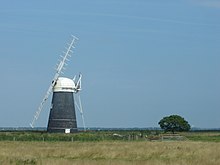Halvergate Marshes
Notification 1995 | | |
| Natural England website | ||
The Halvergate Marshes are an area of
History
Halvergate Marshes were an estuary in Roman times and remained a tidal creek into the Medieval period.[10][11] By the time of Domesday Book the land was already being used for grazing sheep, with Halvergate being recorded as having 960 sheep at the time, a larger amount than any other part of the marshes.[11] Some evidence of possible salt workings also remains.[10] Around 400 years ago the land was drained and converted to grazing marsh using a series of windpumps or windmills and drainage ditches. It was used mainly to graze sheep and cattle, although was occasionally farmed as arable land until coastal flooding in the 1780s.[11]
Arable ploughing in the 1960s and 70s damaged the ditch landscape and ecology and in the 1980s further draining was undertaken.
The marshes are dotted with
Geography
Halvergate Marshes is the largest area of traditionally managed grazing marsh in the Broadland area.
The area is sparsely populated with a scattering of isolated farms across the marshes, although it may have been more populated in the Medieval period.

Flora and fauna
Halvergate Marshes support a range of habitats besides grazing marsh, including areas of unimproved pasture, wet fen meadow, reed bed and alder carr. A band of woodland lies along the western edge of the marshes. The drainage ditches which cross the marshes are deemed to be of "outstanding importance for nature conservation" and support a range of freshwater and
Freshwater ditch communities, which lie mainly along the western side of the SSSI area, are recognised as being of "being of international importance" and support species such as broad-leaved pondweed Potamogeton natans, water violet Hottonia palustris and the nationally scarce whorled water milfoil Myriophyllum verticillatum. Other areas of ditches support species such as the nationally scarce water soldier Stratiotes alludes, fen pondweed Potamogeton coloratus, hairlike pondweed Potamogeton trichoides and water parsnip Sium latifolium. The area of ditch close to Breydon Water are more brackish in nature and feature species such as soft hornwort Ceratophyllum submersum and the nationally scarce stiff saltmarsh grass Puccinellia rupestris.[13]
Invertebrate species associated with the drainage ditches include the nationally rare species Norfolk hawker dragonfly
Birds typically found on Halvergate Marshes include both wintering species such as
Management
The
References
- ^ Coastal and Floodplain Grazing Marsh - Habitat Action Plan Archived 2014-02-23 at the Wayback Machine, Norfolk Biodiversity Partnership, December 2005. Retrieved 2014-02-20.
- ^ "Designated Sites View: Halvergate Marshes". Sites of Special Scientific Interest. Natural England. Archived from the original on 12 June 2018. Retrieved 12 June 2018.
- ^ "Map of Halvergate Marshes". Sites of Special Scientific Interest. Natural England. Archived from the original on 12 June 2018. Retrieved 12 June 2018.
- ^ "Breydon Water". Local Nature Reserves. Natural England. Retrieved 2 June 2018.
- ^ "Designated Sites View: Broadland". Ramsar Site. Natural England. Retrieved 25 May 2018.
- ^ "Designated Sites View: Breydon Water". Ramsar Site. Natural England. Archived from the original on 12 June 2018. Retrieved 25 May 2018.
- ^ "Designated Sites View: The Broads". Special Areas of Conservation. Natural England. Retrieved 25 May 2018.
- ^ "Designated Sites View: Broadland". Special Protection Areass. Natural England. Retrieved 25 May 2018.
- ^ "Designated Sites View: Breydon Water". Special Protection Areass. Natural England. Retrieved 25 May 2018.
- ^ Broads Authority, 2006. Retrieved 2014-02-20.
- ^ a b c d Williamson.T (1997) The Norfolk Broads" a landscape history, Manchester University Press.
- ^ Cook. H.F & Williamson.T (1999) Water Management in the English Landscape: Field, Marsh and Meadow, Edinburgh University Press.
- ^ a b c d e f Halvergate Marshes Archived 2014-02-25 at the Wayback Machine, SSSI citation, Natural England. Retrieved 2014-02-20.
- Broads Authority. Retrieved 2014-02-20.
- ^ Aitken Clark obituary, The Guardian, 2010-04-19. Retrieved 2014-02-20.
- ^ Brouwer.F & van der Straaten.J (2002) Nature and Agriculture in the European Union: New Perspectives on Policies that Shape the European Countryside, Edward Elgar Publishing, p.202.
- ^ Heaven on earth, Wickhampton, Norfolk, The Guardian, 2004-05-10. Retrieved 2014-02-20.
- ^ Broads ESA Archived 2014-02-25 at the Wayback Machine, Natural England. Retrieved 2014-02-20.
- ^ Berney Marshes and Breydon Water - our work here Archived 2014-02-25 at the Wayback Machine, Royal Society for the Protection of Birds. Retrieved 2014-02-20.
- ^ Berney Marshes and Breydon Water - seasonal highlights Archived 2014-02-25 at the Wayback Machine, Royal Society for the Protection of Birds. Retrieved 2014-02-20.
- ^ Further award for top Norfolk beef unit Archived 2014-02-27 at the Wayback Machine, Eastern Daily Press, 2007-11-10. Retrieved 2014-02-21.
